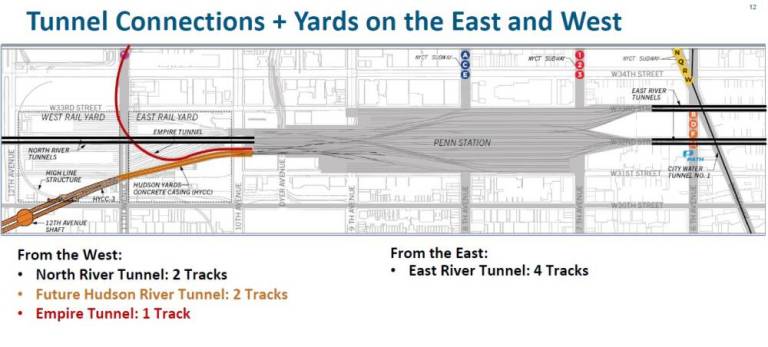https://www.westsidespirit.com/news/...tion-ED3555107
Railway Giants Finally Unveil Why They Need to Expand Penn Station
Due to increasing demand for trains at Penn station, the three big rail users–MTA, Metro North and NJ Transit–said they need to expand the present station to meet exploding demand. Bars, retail outlets a church and a parking garage could be in peril once again of being demolished.

Michael Oreskes
05 Aug 2024
Quote:
Demand for rail service into Penn Station is growing quickly again, post-covid, and the three big railroads told a community forum they will need to expand the station in the next decade or so to accommodate the increase.
The bulk of the growth is coming from New Jersey, said officials of Amtrak and NJ Transit, but the MTA said it concurs with the need for expansion and has plans of its own for more trains as Metro North joins the Long Island Railroad in serving Penn Station.
The officials spoke at a forum organized to address claims by community and advocacy groups that the railroads needlessly plan to tear down the block south of Penn Station, often referred to by its tax roll designation, Block 780, to expand the station. That block contains bars, a strip club, a Catholic Church, a big parking garage, a deli, and fast food and pizza outlets, among other businesses.
|
Quote:
The railroads said there was a germ of a good idea in through-running, for the future, but that it would not solve the need to meet growing demand in the near-term.
Speaking at the forum held at NYU, Petra Messick, a senior Amtrack official, stressed that no decision had been made to demolish Block 780, and that the railroads were looking at expansion alternatives both north and south of the current station. Whatever plan the railroads adopt will be subjected to an environmental review that will include public hearings, she said.
“Trans-Hudson train service into Penn Station needs to be doubled, at least, to meet the existing and future needs of the region,” Said Messick. “All through-running or hybrid configurations within the footprint of the existing station fall short of this goal.”
|
Quote:
Doubling service under the Hudson will become possible in the 2030’s, Messick noted, when construction is completed on what is known as the Gateway project, a rebuilding of the rail line between Newark and Penn Station New York that includes two new tracks under the Hudson River to supplement the two tracks built under the river in 1910 by the now defunct Pennsylvania Railroad.
Gateway, which is under way, will allow more trains, but the question bedeviling both the railroads and political leadership is where to put all those new trains in the already overcrowded Penn Station.
To bolster her argument that an expansion will be needed, Messick presented a well-known transportation consultant, Foster Nichols of the firm WSP, who said he had analyzed two proposals from advocacy groups, ReThink NYC and TriState Trnsportation, to overhaul railroad operations as an alternative to expanding the station.
|
Quote:
“Implementing through-running will be time consuming, costly and disruptive,” Nichols said, thus risking “the timely development of urgently needed station capacity.”
He said, for example, that it would be possible to reconfigure tracks and widen platforms within the present footprint of the station, but the price would be ten years of service disruptions as bad as the one summer when New Jersey Transit had to divert more than a quarter of its trains to Hoboken.
|
Quote:
“Gateway is the highest infrastructure priority in the entire region–and even in the nation,” said Tom Wright, President of the RPA. “New York City exists because it has access to a large, diverse and talented workforce that includes residents of the five boroughs and also over ten million residents of the wider region.”
Over a million suburbanites hold jobs in New York City, Wright noted, and nearly half, 450,000 live in New Jersey. He said that even under conservative projections–incorporating more working from home and slower growth rates–transit ridership across the Hudson will be 15 percent to 32 percent higher by 2050.
|
Quote:
While Amtrak, which owns Penn Station, has been leading the railroads on the questions of capacity and expansion, The MTA is leading a separate process to improve the train hall above the tracks.
The rebuilding of Penn Station is one of the most complex development projects in the city’s history. For a long time, the future of the station was tied to a major redevelopment of the neighborhood that called for the construction of ten new office towers and an apartment building.
But with the office market in flux, and the principal property owner slow walking new construction, Governor Hochul “decoupled” Penn Station from this larger development plan.
|
__________________
NEW YORK is Back!
“Office buildings are our factories – whether for tech, creative or traditional industries we must continue to grow our modern factories to create new jobs,” said United States Senator Chuck Schumer.
|



